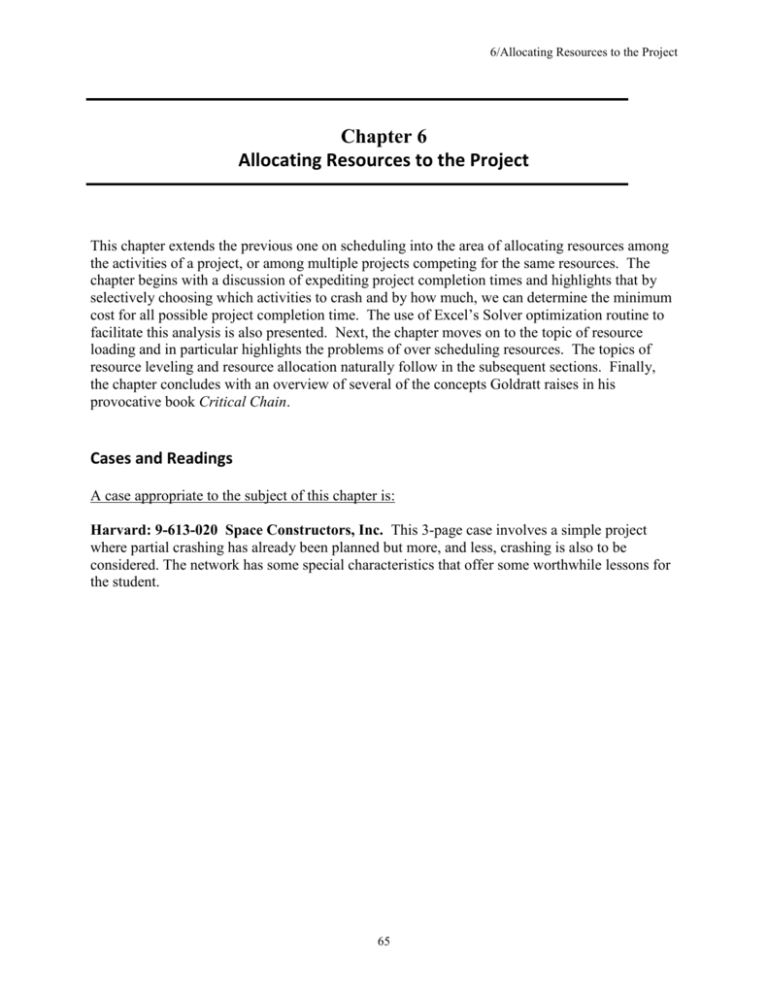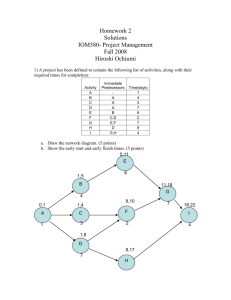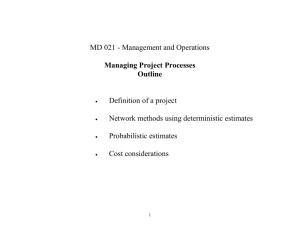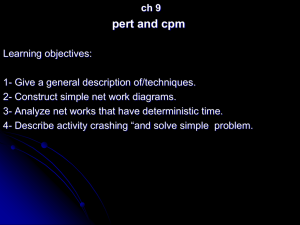ch06
advertisement

6/Allocating Resources to the Project Chapter 6 Allocating Resources to the Project This chapter extends the previous one on scheduling into the area of allocating resources among the activities of a project, or among multiple projects competing for the same resources. The chapter begins with a discussion of expediting project completion times and highlights that by selectively choosing which activities to crash and by how much, we can determine the minimum cost for all possible project completion time. The use of Excel’s Solver optimization routine to facilitate this analysis is also presented. Next, the chapter moves on to the topic of resource loading and in particular highlights the problems of over scheduling resources. The topics of resource leveling and resource allocation naturally follow in the subsequent sections. Finally, the chapter concludes with an overview of several of the concepts Goldratt raises in his provocative book Critical Chain. Cases and Readings A case appropriate to the subject of this chapter is: Harvard: 9-613-020 Space Constructors, Inc. This 3-page case involves a simple project where partial crashing has already been planned but more, and less, crashing is also to be considered. The network has some special characteristics that offer some worthwhile lessons for the student. 65 6/Allocating Resources to the Project Answers to Review Questions 1. Given the fact that a project’s resource requirements are clearly spelled out in the project’s action plan, why are PMs so concerned with resource allocation? There can be a variety of reasons why resource allocation is of concern to the PM despite having a properly completed action plan. For example: o The action plan only lists general categories of resource requirements such as engineering, purchasing, marketing, and production. In these cases, the project manager must still arrange to get the specific resources (e.g., personnel) needed. o The action plan may only specify how much of the resource is needed and precedence between the activities relationships, it may not specify exactly when the PM will need these resources. o Although the action plan specifies the amount of a resource needed for a particular project, there may not be a mechanism in use that balances the load of resources across multiple projects. This can lead to conflicts and the creation of bottleneck resources. 2. Explain the difference between a project that has a fixed delivery day and one that has a fixed limit on resource usage. A project with a fixed delivery date can vary the level of resources used to meet a firm project completion date. A project with a fixed limit on resource usage cannot obtain additional resources but can possibly delay the project completion date. Why might a PM be interested in this difference? The reason this distinction is important is that it specifies which of the fundamental tradeoffs the project manager can exercise. In the case of projects with fixed delivery dates, only performance and cost (resource usage) can be varied. In projects with fixed resource usage levels, only schedule and performance can be varied. 3. What does it mean to “fast track” a project? Fast-tracking is a technique whereby key stages of the project are overlapped. In the construction industry, this might entail beginning construction before the design and planning are finished. In the pharmaceutical industry this may entail developing the production process as the new drugs are being developed and tested. 66 6/Allocating Resources to the Project 4. List as many things as you can think of that should be entered into a specific resource’s calendar. Information that should be entered into a resource’s calendar include: o The resource’s availability (e.g., days in week available, total hours available per week, hours available each day). o Times the resource will not be available (e.g., lunch, weekends, holidays, vacations, scheduled maintenance), and o Resource cost (e.g., cost per unit of usage, cost for overtime and overuse, known changes in future resource cost). 5. Explain why project-oriented firms require excess resource capacity. In project oriented firms there is much more uncertainty about the timing of resource needs since the resources primarily move between projects rather than moving between projects and a functional department. Therefore, extra resource capacity is needed as a buffer given the greater level of uncertainty present. 6. The arrival and departure times of commercial aircraft are carefully scheduled. Why, then, is it so important to have excess capacity in the airport control tower? Although the arrival and departure times may be carefully scheduled, we all know that actual arrivals and departures often deviate significantly from these schedules. Therefore, a significant amount of uncertainty is present and greatly complicates the ability of the airport control system to handle arrivals and departures. Indeed unplanned events (e.g., weather delays, equipment malfunctions, late flight crews, and so on) often cascade through the system further compounding the problem. Therefore, excess capacity in control towers is needed as a buffer given this level of uncertainty. Clearly, the cost of not having this capacity greatly exceeds the cost of some idle capacity. 7. Explain the difference in the problems faced by a PM who is short of secretarial resources and one who is short of a “Walt.” The PM that is short of secretarial resources does not face that great of a problem as this type of resource is relatively abundant and not usually critical to the project’s ultimate success or failure. The PM that is short of a “Walt” (i.e., an individual with expertise and knowledge in an area) faces a much more daunting problem because a Walt is a scarce resource that is important to the project’s successful completion and there are no readily available substitutes for a Walt. 67 6/Allocating Resources to the Project 8. When allocating scarce resources to several different projects at the same time, why is it important to make sure that all resource calendars are on the same time base (i.e., hourly, daily, or weekly …)? One reason it is important to ensure the resource calendars are on the same time base is because task duration is not usually dictated by the number of labor hours required to complete the task, but rather by the calendar time required to complete it. 9. List and describe the three most common criteria by which to evaluate different resource allocation priority rules. The three criteria are: o Schedule slippage … a measure of the delay suffered by projects as a result of the application of a resource allocation priority rule. o Resource utilization … a measure of the total resource cost (including costs such as the cost of hiring, firing, and maintaining resource inventories) under different allocation rules. o In-process inventory … a measure of the cost of unfinished work in the system. 10. Why is the problem of allocating scarce resources to a set of projects similar to the problem of scheduling a job shop? In a job shop allocating resources (equipment and workers) to jobs or orders is required. In projects, a similar allocation is required where specific resources must be allocated to tasks and activities which represent the jobs. 11. What is meant by the “student syndrome”? The “student syndrome” refers to situations in which people wait until the last possible minute to begin a task. Its name is derived from the belief that students often delay the start of an assignment until just before it is due. 68 6/Allocating Resources to the Project Suggested Answers to Discussion Questions 12. Describe the fundamental trade-offs when deciding whether or not to crash a project. The fundamental trade-off in crashing a project is between schedule and budget. Specifically, crashing entails employing additional resources (cost) in order to reduce the project’s completion time. If the decision is made to crash, what additional trade-offs must be made? If it is decided to crash a project other trade-offs may be necessary in terms of the completion time of other projects and perhaps the performance of this and other projects. 13. Discuss the advantages of “labor pools” in a project – oriented company. The main advantages of “labor pools” versus dedicating workers to specific projects are: o Less waiting time for key resources. o The ability to level resource usage, and o The ability to substitute one worker for another should one become unavailable. Are there any potential disadvantages with the use of pools? Potential drawbacks include: o Workers who do not identify with a particular project. o Personnel who may not be well trained in specific tasks required by the assignment. o Fewer opportunities for job enlargement. All of these may lead to lower levels of job satisfaction, as well as lower morale and motivation. 69 6/Allocating Resources to the Project 14. What purpose(s) might be served by using each of the following priority rules for allocating scarce resources? a. As late as possible. b. Shortest task duration time first. c. Minimum slack first. a. Starting a task as late as possible … preserves resources and delays cash flows as long as possible. b. Allocating resources to tasks with the shortest durations … first maximizes the number of tasks that can be completed within a certain time period. c. The minimum slack priority rule … is used to minimize the number of late activities. 15. Linking a group of projects together with pseudoactivities creates a sort of superproject. What does this mean, and why would anyone want to do it? Just as a project consists of tasks and activities with precedence relationships, a superproject can be thought of as consisting of a group of projects with precedence relationships. In the superproject, psuedoactivities are used to show the precedence relationships among the projects. These precedence relationships may be actual technological constraints (e.g., the product development project must be completed before the process development project) or simply a reflection of management’s priorities. The reason for creating a superproject is to help identify important relationships and dependencies across the projects and use this information to better plan the usage of key resources. 16. Describe in your own words what is meant by Goldratt’s critical chain. Traditionally, in project management the concept of the critical path is used. More specifically, the critical path is defined as the path(s) that if delayed will delay the completion of the entire project. One shortcoming of the critical path approach is that it only considers task precedence information and does not consider issues related to resource usage. The critical chain addresses this concern and considers both technical precedence relationships as well as the resources that will be used to complete the tasks. Therefore, the critical chain refers to the longest chain of consecutively dependent events including both technological as well as resource dependencies. 70 6/Allocating Resources to the Project How does it work? The critical chain works by defining two sources that can delay the completion of the project. One source of delay is uncertainty in the tasks that comprise the critical chain. A project buffer is added to guard against these uncertainties. The second source of delay is uncertainty in the tasks external to the critical chain. A feeding buffer is added to these paths to help ensure they do not delay the tasks on the critical chain. 17. Projects A and B are both nearing completion. You are managing a super important project C that requires an immediate input of resource being used by both projects A and B, but is otherwise unavailable. Project A has a Type 1 life cycle. Project B’s life cycle is Type 2. From which (or both or neither) do you borrow the resource? Why? In this case it would be best to borrow from project A. According to Figure 6-20, as a Type 1 project, fewer resources will have little impact on project A’s performance as it nears completion. Conversely, as a Type 2 project, taking resources away from project B as it nears completion will dramatically reduce its performance. 18. Goldratt suggested that to avoid the student syndrome,” it is a good idea to set the activity durations so short that there is a high probability that the task will not be finished on time. On the other hand, it has long been known that setting up people for failure is strongly demotivating. What should the PM do? There is a delicate balance between setting goals that people believe are impossible to achieve and therefore result in demotivating the team versus stretch goals that really push the team and serve to motivate the team. The project manager should not set goals that have extremely low probabilities of success, but may find it desirable to set goals that do have a reasonable chance of not being met (say 40 to 60 percent). 19. Describe as many types of resource allocation problems as you can, based on the situations described in this chapter. The chapter identifies three types of resource allocation problems: o o o Available resources (resource loading). Scarce resources – single projects. Scarce resources – multiple projects. Resource loading recognizes the existence of needed resources and ensures that they are allocated to the project when needed. An example would be a construction site where the electrical work is 71 6/Allocating Resources to the Project subcontracted to an external supplier. The main task is to determine that the external firm can have the necessary skilled work force on site at the appropriate time. Scarce resources are those with limited availability and the key elements of the project have to be scheduled around that availability of the resource - even if a firm has just a single project. An example of this situation would be the reliance of a construction site on a specific piece of equipment such as a crane. The allocation of scare resources becomes far more complex when the same resources are need on more than one project. In this case, the utilization of the resource on project A will also have an impact on project B (and, possibly, other projects). As indicated in the chapter, the company will need to apply one of the six priority rules to determine which project shall have the first use of the scarce resource. Solutions to Problems 20. This project involves the landscaping of a building site. a. The Gantt chart for the project. b. Assuming a five day week, the critical path is: A-C-D-E-G and the project duration is 14 days. 72 6/Allocating Resources to the Project c. Since each resource is assigned 100 per cent to each task, the resource constraints are: o Resource X is over utilized on the Friday of week 1, Monday of week 2, and Tuesday of week 3. o Resource W is over utilized on Tuesday or week 3. d. After leveling the resources, the project duration is 17 days and the critical path is A-C-D-F-G. e. If it is necessary to shorten the project duration without overallocating the resources then there are two options: o Adding an additional X resource would shorten the project by 2 days, o Leveling the W resource would be 15 days. 73 6/Allocating Resources to the Project The project duration is 13 days when the resources work weekends and after leveling. 21. Provided are the predecessors, normal time, normal cost, crash time and crash cost for an eight activity (a to h) project. a. The network for this project is as follows: 4 1 G D A E 3 B 5 H 6 C F 2 The critical path is B-C-E-H. The project duration and cost for the all normal level of project activity is 20 days and $400, respectively. b. The crash costs per day for all activities are shown in column F. A 4 5 6 7 8 9 10 11 12 13 Activity a b c d e f g h B Normal Time 5 4 7 2 3 8 5 6 C Normal Cost $50 $40 $70 $20 $30 $80 $50 $60 74 D Crash Time 3 2 6 1 E Crash Cost $150 $200 $160 $50 F Crash Cost/Day 50 80 90 30 5 4 3 $290 $100 $180 70 50 40 6/Allocating Resources to the Project c. The spreadsheet below was created to find the optimal way of getting to an 18-day delivery time. As shown, the total normal cost is $400 (cell C14) and the total crash cost is $80 (cell I14) for a total project cost of $480 (cell B2). The 18 day duration was achieved by crashing activity H 2 days (cell H13). A 1 Deadline: 2 Total Cost: 3 4 5 Activity 6 a 7 b 8 c 9 d 10 e 11 f 12 g 13 h 14 Total 15 16 17 Node 18 2 19 3 20 4 21 5 22 6 B 18 $480 C D E Normal Time 5 4 7 2 3 8 5 6 Normal Cost $50 $40 $70 $20 $30 $80 $50 $60 $400 Crash Time 3 2 6 1 Crash Cost $150 $200 $160 $50 5 4 3 $290 $100 $180 F G H I Crash Max Crash Amt Crashing Cost/Day Amt to Crash Cost 50 2 0.0 0.0 80 2 0.0 0.0 90 1 0.0 0.0 30 1 0.0 0.0 0 0.0 0.0 70 3 0.0 0.0 50 1 0.0 0.0 40 3 2.0 80.0 $80 J Actual Time 5 4 7 2 3 8 5 4 Event Time 4 11 13 14 18 The optimal solution using Solver was found in the following way: o Cell I14 was specified as the target cell to minimize. o The ranges H6:H13 and B18:B22 were specified as the changing cells. The following constraints were added: o o o o o o o o o o o o H6:H13 < G6:G13 (maximum amount each activity can be crashed) B18 > J7 (node 2) B19 > B18 + J8 (node 3) B19 > J6 (node 3) B20 > B19 + J9 (node 4) B21 > B18 + J11 (node 5) B21 > B19 + J10 (node 5) B22 > B20 + J12 (node 6) B22 > B21 + J13 (node 6) B22 < B1 (node 6 – project deadline) 6:H13 > 0 and B18:B22 > 0 (all decision variables must be > 0) The “Assume linear model” check box was also selected. d. The optimal 16-day project duration can be found by entering 16 in cell B1 and then resolving using Solver. The optimal solution calls for crashing activity H 3 days, B 1 day, and D 1 day. The cost of completing the project in 16 days is $400 + $230 = $630. 75 6/Allocating Resources to the Project e. If all activities are crashed as much as possible, the project can be completed in 14 days. Entering 14 in cell B1 and resolving, it is discovered that the project can be completed in 14 days at a cost of $400 + $ 400 = $800. f. See solutions to c – e above. 22. Given the following AOA network, what is the first activity to be given extra resource? The following Table shows the activity, duration, successors, critical followers, and slack associated with each of the four activities: Activity Duration Successors Critical Followers Slack A B C D 4 3 7 5 D C, D D None D C, D D None 6 0 0 0 a. Using the shortest task first priority rule: Task B has the shortest duration. b. Minimum slack first … Tasks B, C, and D all have zero slack. c. Most critical followers … Task B has the largest number of critical followers. d. Most successors … Task B has the largest number of successors. 23. Given the project shown in Figure 5-10 of Chapter 5 and the fact that the facility used by activities c and d is scarce, which activity would benefit from each of the rules? The following Table shows the activity, slack, critical followers, duration, and latest start time for activities c and d: Activity Slack Followers Critical Followers Duration Latest Start Time C D 3 2 F, I G, H, J None H, J 76 3 4 8 7 6/Allocating Resources to the Project a. Using the minimum slack rule: Activity D has the least amount of slack and therefore would get the facility first using this rule. b. Most followers … D has the most followers and would get the facility first. c. Most critical followers … D has the most critical followers and would get the facility first. d. Shortest task first … C has a smaller duration and would get the facility first. e. With the “as late as possible” priority rule, the latest start times are used. In this case activity C has a LSof 8 and D has a LS of 7. In using this rule it only makes sense to assign the facility to the resource with the earliest LS or activity D. Incidents for Discussion Suggested Answers Lab Results, Inc. Question 1: Do you think Sam’s plan is going to work? Why or why not? No, Sam’s plan of just adding this work to his current work load without any additional resources will not work for a number of reasons: o There is little or no excess capacity in the current operation. If Sam is paying overtime weekly, his current staff are working beyond normal capacity now. Adding additional work through this new project will only add to this. o Sam’s plan does not take into account vacation or sick time for his technicians. Four months is also a long time to ask the staff to work more overtime on top of what they are already working. o There is also no time built in to deal with any issues that may come up, such as increases in work load from his other clients, problems with equipment, etc. If he continues with this plan, quality and the ability to meet the scheduled delivery of results will suffer. How would you handle the bid on the new project? Among the steps one could take would be to: 77 6/Allocating Resources to the Project o Redesign the project plan for this new job to include additional resources to complete the additional work. o Use this as an opportunity to build excess capacity into the current system. Focusing on the costs associated with additional resources instead of paying overtime to already overworked staff would reduce the project cost and improve the chance of meeting the projects specification for quality and delivery. Question 2: Would Crystal Ball be useful in assessing Sam’s plan and changing it, if necessary? If Sam has data on the ebb and flow of demand on this work force across time, he can use Crystal Ball to simulate the amount of overtime his workforce will be expected to work if he wins the contract. Further, he can find the amount of system capacity consistent with any given level of overtime. Southern Kentucky University Bookstore Question 1: Is the minimum slack rule a reasonable way to schedule resources of the Textbook division? Why or why not? No. The projects are not combined and the minimum slack on one may receive resources when its slack is more than the minimum slack on another project. Question 2: What complication is added by making this project four separate projects? The interactions between these projects are important and must be accounted for by scheduling this as a multiproject plan. Peak resource loads need to be determined in advance and leveled. The overall project schedule should be determined with the resource utilization of each area in mind. Suggested Case Analyses and Solutions St. Dismas Assisted Living Facility Resource Usage – Part 4 Teaching Purpose: In this installment students are required to develop Gantt charts for the resources and prepare a resource calendar using MSP. Question 1: Prepare a Gantt chart with resources for the action plan Dr. Alison submitted. Begin this project on January 2. Prepare a resource calendar for Dr. Alison. 78 6/Allocating Resources to the Project The following is the Gantt chart of the action plan presented in the case. This Gantt chart was prepared using MSP with a resource calendar for Dr. Alison and Dr. Link with a workweek of Monday through Friday, and a daily schedule of 8 a.m. to 5 p.m. with an hour of non-working time for lunch. The resource calendar was applied using the “Change Working Time” under the “Tools” menu in MSP. (The issue of scheduling the “Test of the assessment tool…” will be addressed in answer #3 & #4). Note: the case stated to start the project on January 2, if students use the year 2000, the project will actually begin work on January 3rd, as January 2nd is a non-working day. If students use January 2, 2001 (or later), the project will start on January 2 nd. The start date used in these examples is January 2, 2000, to coincide with the year that the case started. The following is the standard resource calendar used for Dr. Alison for all of the tasks defined by the action plan. Since the case outlined that a resource scheduling conflict would only pertain to the task of “Testing the assessment tool”, it is not appropriate to constrain Dr. Alison on the project for any other tasks. Note: The following printout excerpt was prepared using the Reports feature in MSP. The issue of how to handle the specific scheduling constraint will be addressed in answer #3 below. 79 6/Allocating Resources to the Project Question 2: How would you handle Dr. Alison’s resource problem? The resource issue that Dr. Alison has should be handled by adjusting the project schedule to allow for the scheduling constraints. The case states that Dr. Alison can perform all of the project steps within his 8 a.m. to 5 p.m. normal work week, however he will only be able to perform the “Test of the assessment tool” during his administrative time on Wednesday’s from 8 a.m. to 12 p.m. Since that step is important to the success of the project, it is necessary to adjust the project plan to reflect Dr. Alison’s scheduling conflict. It is not appropriate to add another resource, or overallocate Dr. Allison to get this task done within the time frame specified. There are several different ways to set a resource constraint on the “Test the tool” task, Step #4 in the action plan. MSP 2007allows you to create a specific calendar for a step in an action plan. Simply create a New calendar in the Tools menu, “Change working time” section. In the new calendar create a schedule that has its working time as Wednesdays, 8 a.m. to 12 p.m., and all other days as non-working. Then you apply this calendar to step 4 in the action plan. (This is done by selecting the task information box for Step #4, going to the “Advanced” tab, and selecting the new calendar you just created. These steps are all outlined in the Help section, under “Assigning a calendar to a task”.) Once you apply the new calendar, MSP will automatically adjust the Gantt chart to reflect the changes in the schedule. Note: If students are using MSP98, the schedule constraint can be incorporated into the project by adjusting Dr. Alison’s resource calendar for only the time period that this step takes place (Jan 19 – Jan 26).] Question 3: Given Dr. Alison’s availability, how long will it take to complete testing of the assessment tool? Based on Dr. Alison’s availability to complete the step “Test of the assessment tool”, Step #4 will now take from January 19, 2000 – January 26, 2000. Please note that the task’s duration remains at 6 hours, however with Dr. Alison only available to work on the step from 8 a.m. – 12 p.m. one day a week, the step will now take an extra calendar week to complete. Without the constraint the task could begin as soon as Step #3 was completed, January 14. However, with the constraint applied, Step #4 cannot begin until the following Wednesday when Dr. Alison is available, and he can only work 4 hours on that day, so another 2 hours the following Wednesday is necessary to complete the task. 80 6/Allocating Resources to the Project Question 4: Prepare a Gantt chart for Dr. Alison’s plan incorporating any changes you recommend. The Gantt chart below shows the scheduling changes adjusted for the availability of Dr. Alison to complete step #4 in the action plan. Or with a more detailed view of the calendar: 81 6/Allocating Resources to the Project Charter Financial Bank Teaching Purpose: This case provides students with opportunity to evaluate alternative crashing strategies. Question 1: What is the cost of completing this project if no overtime is used? How long will it take to complete the project? The network diagram shown below can be constructed from the information in the case. Test 5 DB 1 Benchmarking 2 Pla n 3 Design 4 Pages Forms 6 8 e s t 7 The time to complete the project at a normal level of activity is 43 days and the cost is $100,650. Question 2: What is the shortest amount of time in which the project can be completed? What is the cost of completing the project in the shortest amount of time? When all the activities are crashed their maximum amount, the project is completed in 30 days. In the spreadsheet below, Solver was used to find the least costly way to crash the project such that it was finished in 30 days. Column H details the amount each activity was crashed. The incremental cost required to shorten the project these 13 days is $26,250 (cell I13). 82 6/Allocating Resources to the Project 1 2 3 4 5 6 7 8 9 10 11 12 13 14 15 16 17 18 19 20 21 22 23 A Deadline: Total Cost: Activity Benchmark Plan Design Database Webpages Forms Test Total Node 2 3 4 5 6 7 8 B 30 $126,900 Normal Time 10 5 15 10 10 7 3 C D E F G H I J Normal Crash Crash Crash Max Crash Amt Crashing Actual Cost Time Cost Cost/Day Amt to Crash Cost Time $15,000 7 $18,750 1250 3 3.0 3750.0 7 $3,750 3 $4,500 375 2 2.0 750.0 3 $45,000 10 $58,500 2700 5 5.0 13500.0 10 $9,000 7 $11,250 750 3 2.0 1500.0 8 $15,000 8 $19,500 2250 2 2.0 4500.0 8 $8,400 7 0 0.0 0.0 7 $4,500 2 $6,750 2250 1 1.0 2250.0 2 $100,650 $26,250 Event Time 7 10 20 28 28 27 30 Using Solver required the following steps: o Cell I13 was specified as the target cell to minimize. o The changing cells included the ranges I6:I12 and B17:B23. In addition to specifying “Assume linear model” the following constraints were entered: o o o o o o o o o o o o H6:H12 < G6:G12 (limit on the amount each activity can be crashed) B17:B23 > 0 & H6:H12 > 0 (nonnegativity constraints) B17 > J6 (node 2) B18 > B17 + J7 (node 3) B19 > B18 + J8 (node 4) B20 > B19 + J9 (node 5) B20 > B21 (node 5) B20 > B22 (node 5) B21 > B19 + J10 (node 6) B22 > B19 + J11 (node 7) B23 > B20 + J12 (node 8) B23 < B1 (deadline specified) 83 6/Allocating Resources to the Project Question 3: Suppose that the benchmarking study actually required 13 days as opposed to the 10 days originally estimated. What actions would you take to keep the project on a normal schedule? The spreadsheet presented in question 2 can be modified such that the benchmarking study’s normal and crash times are now 13 days implying that this task can no longer be crashed. Then the spreadsheet can be resolved using Solver and specifying a deadline of 43 days. As shown in the spreadsheet, below the project can still be completed in 43 days by crashing the Plan task by 2 days and the Test task by 1 day. The cost of crashing these two tasks will increase the project cost by $3,000. Question 4: Suppose the President wanted the website launched in 35 days. What actions would you take to meet this deadline? How much extra would it cost to complete the project in 35 days? The spreadsheet presented in question 2 can again be modified. This time 35 is entered in cell B1 and the problem resolved with Solver. Column H in the spreadsheet below details the amounts the various activities should be crashed to meet the 35-day deadline. The extra cost of reducing this project 8 days (43 – 35) is $12,150. A B C D E F G 1 Deadline: 35 2 Total Cost: $112,800 3 4 Normal Normal Crash Crash Crash Max Crash 5 Activity Time Cost Time Cost Cost/Day Amt 6 Benchmark 10 $15,000 7 $18,750 1250 3 7 Plan 5 $3,750 3 $4,500 375 2 8 Design 15 $45,000 10 $58,500 2700 5 9 Database 10 $9,000 7 $11,250 750 3 10 Webpages 10 $15,000 8 $19,500 2250 2 11 Forms 7 $8,400 7 0 12 Test 3 $4,500 2 $6,750 2250 1 13 Total $100,650 14 15 Event 16 Node Time 17 2 7 18 3 10 19 4 23 20 5 33 21 6 33 22 7 30 23 8 35 84 H I J Amt Crashing Actual to Crash Cost Time 3.0 3750.0 7 2.0 750.0 3 2.0 5400.0 13 0.0 0.0 10 0.0 0.0 10 0.0 0.0 7 1.0 2250.0 2 $12,150







